Ah the 80’s in the Philippines – Greenhills was the shopping place to be, New Wave was the new age music, Return of the Jedi was a box office hit, the D&D RPG was making waves in local nerd culture, the Crispa Redbanizers won their second Grandslam – and Ninoy Aquino was just assassinated, leading to a pivotal moment in Philippine history called People Power.
Such is the 1983 backdrop of People Power by GMT Games, a geopolitical board game portraying the struggles and clashes between the Marcos led government forces, the opposition/reform movement led by erstwhile widow Cory Aquino and the communist NPA led by Joma Sison. From the years of 1983 to 1986, the Philippines experienced socio cultural and political changes that defines the Filipino identity to this very day.
Traditionally complex, People Power: Insurgency in the Philippines 1981-1986 is marketed as a COIN board game that is simpler in mechanics, while retaining rich sandbox-like strategy. Did the game accomplish this? Lets find out.
What’s in the Box?
The game comes in the typical bookshelf style 3 inch thick box of GMT. It includes a 22″x17″ mounted map board of the Philippines with certain key cities and zones defined, 3 player boards, 80 wooden bits and pieces in the three faction colors, 36 Event cards, 12 Personality cards, 4 Election cards, 9 Act of Desperation Cards, and 18 AI cards, 3 dice and 12 plastic pawns. Also included are a counters sheet, 3 Players Aids, a rulebook, a playbook and a non-player (AI) rulebook.
The component quality, as in most GMT games, is outstanding, with thick cardboard for tokens, comprehensive rulebooks with detailed examples of play, and vivid colored wooden pieces.
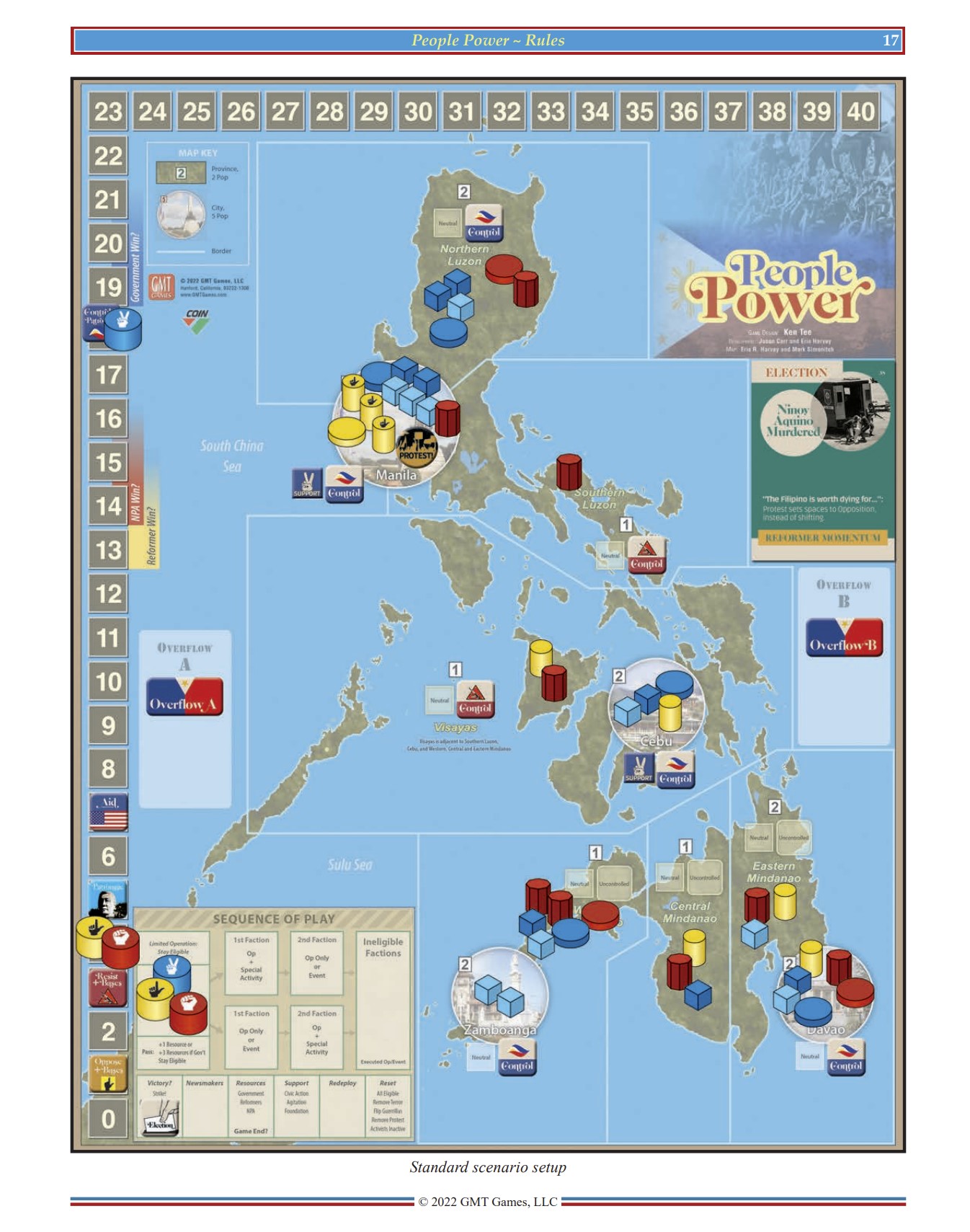
Standard game setup
Players unfamiliar with GMT or wargame style rulebooks may find these 3 part booklets quite intimidating. The rulebook may seem disjointed to players at first since, it seeks to define terms and concepts before delving into sequence of play. But reading thru the rulebook and following it up with the example of play in the playbook will clear almost all questions or confusion about the game.
What is a COIN game?
Designed by Kenneth Tee using the COIN system developed by game designer and CIA analyst Volko Ruhnke, COIN stands for Counter Insurgency. It is a game system that pits powerful, ruling authorities with vast resources and military might against revolutionary or insurgent forces that have limited assets but fight back thru the use of subterfuge, terror, or by galvanizing popular support. These different factions not only have different resources, they also have different victory conditions and different game actions. In People Power these factions are Government, NPA and Reformers, and is designed as a three player game but can be played solo or two player.
In each game turn, an event card is flipped. The top part of this card will have faction symbols that indicate turn order. The lower half of the Event card has two Events which are powerful effects beneficial to specific factions.
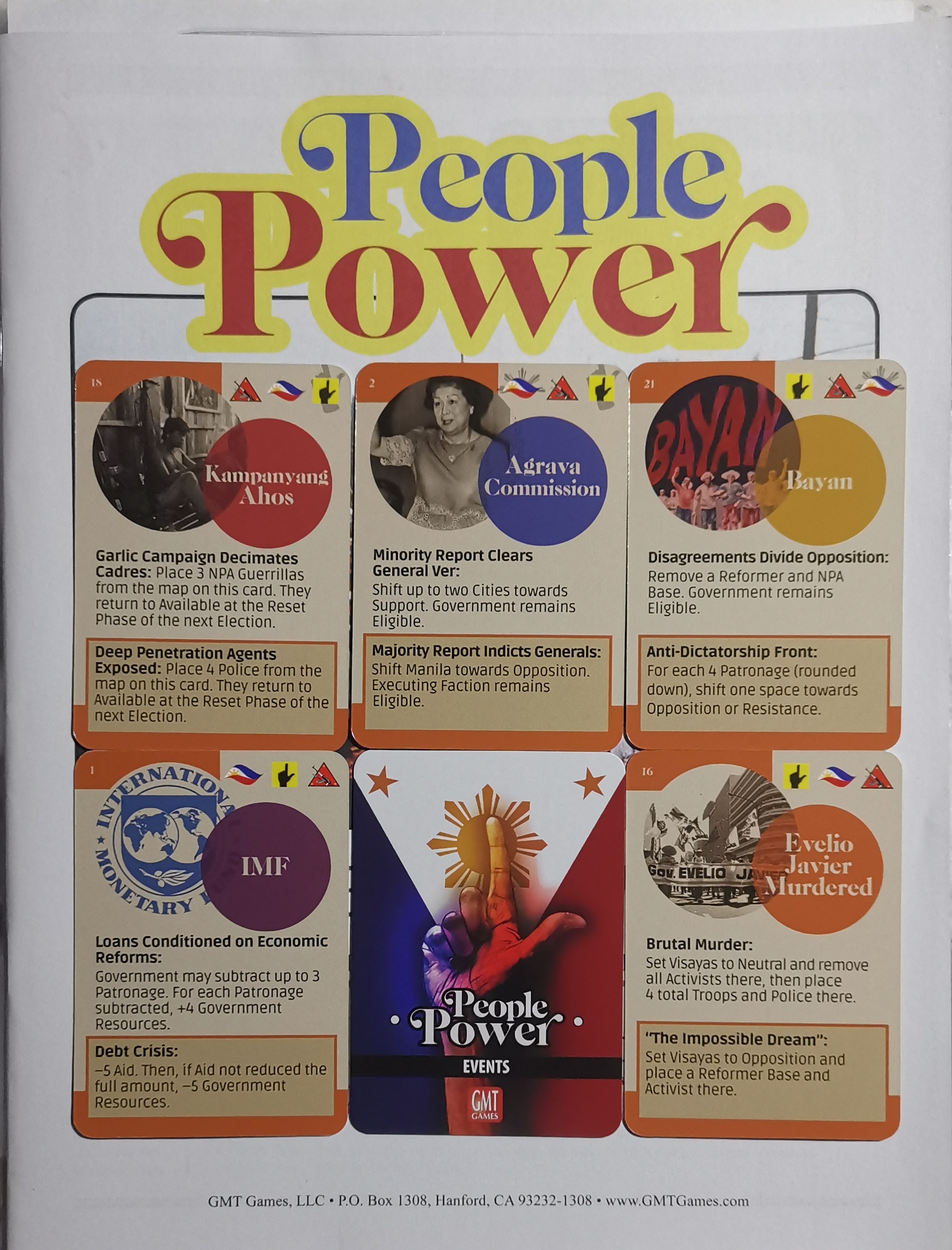
Sample Event Cards and card back
The first eligible faction (as indicated by the faction symbols on the top of the card) chooses actions from a matrix printed on the board. The actions available to the next faction is dictated by the action taken by the preceding faction and so on. And all factions that acted during this turn will be unavailable to act in the next turn, unless you choose to do a restricted action (called a Limited Operation ingame) or pass (to get a small amount of resources). So being eligible in the next round becomes a choice of doing powerful actions this round and passing on the next; or doing very limiting actions this round but being able to act again the next round. Typically, a faction would want to act on an Event card that gives said faction powerful game effects and with no need to use resources; but doing so will make that faction ineligible for the next round. Also, an opponent that goes first, could block a faction seeking to use Event card, by choosing an action in the matrix that will disallow the use of the Event for the succeeding players.

The Sequence of Play Matrix illustrates how the choice of the 1st faction affects the choice available for the 2nd faction
The different main Actions available are Events, Operations+Special Activity, and Operations Only. Factions spend resources to activate these actions, except Events which are free. These actions do differ from faction to faction but in general they allow the player to add units, move forces, setup bases, consolidate control, sway political leaning; and attack or suppress enemy units in the game, or initiate protests or strikes. These main Actions have powerful effects as mentioned, but choosing these options will place the factions that played them in the Ineligible Factions box, so they will not be able to play the next round.
Limited Operations and Pass actions are less powerful but these actions allow the player to be eligible for the next round, possibly setting the player up to use a more powerful Event or to chain certain actions.
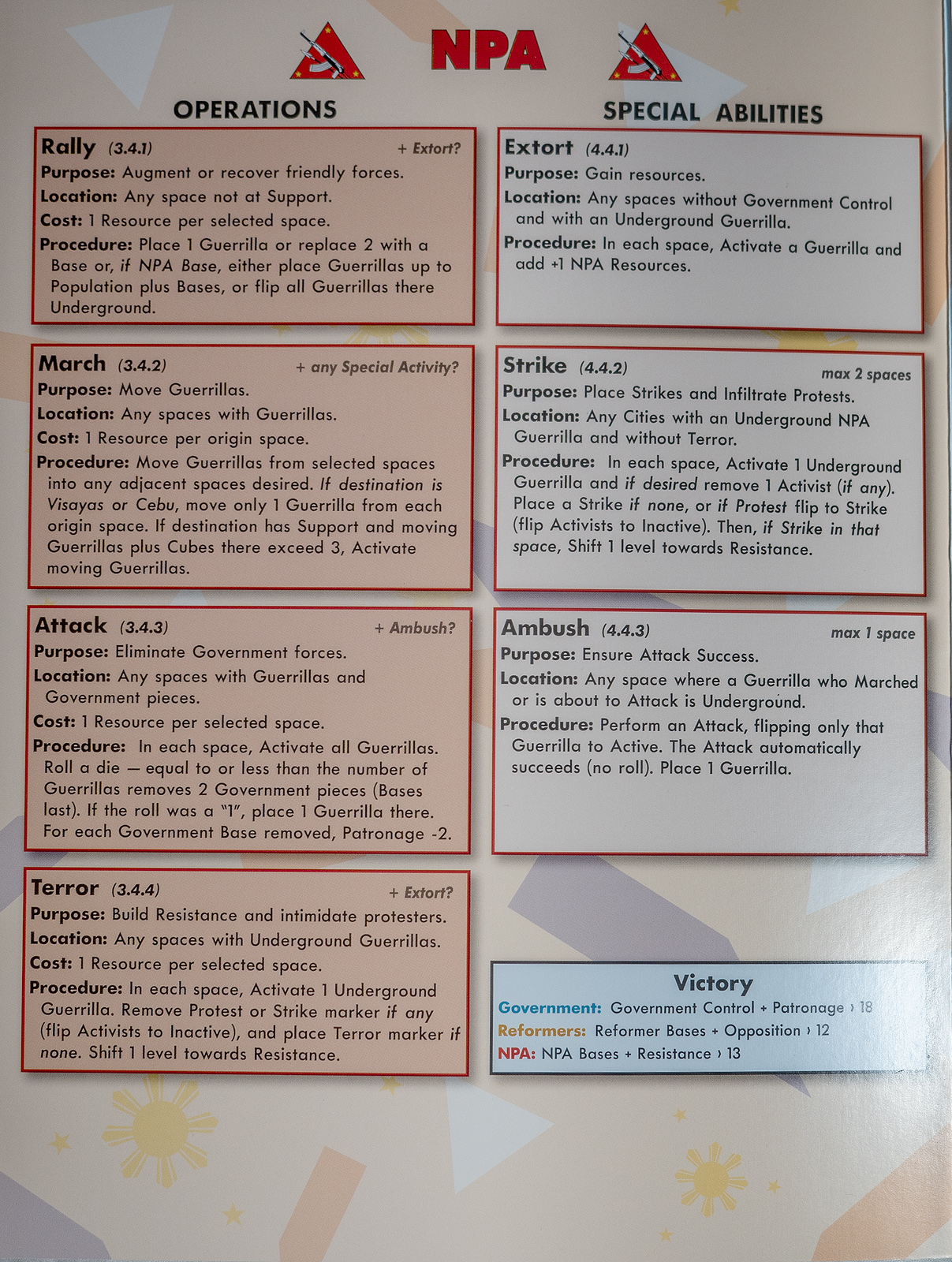
A list of available actions for the NPA
The Insurgent factions in People Power are the NPA and the Reformists. Their units have two sides, a hidden and an active/exposed side. When these pieces are hidden, they cannot be targeted by Government forces, but the ingame effects of these hidden units are limited. However, when they are flipped to their active side by certain game actions or events they have significant game effects, but are now at risk of being targeted or eliminated by Government units. For example a Protest action flips the reformer pieces to their active side and cause political sentiment to shift to their side, and the active units also contest for control of the area but become susceptible to the Government’s police units.
At setup, Election cards are seeded within the Event deck. Gameplay continues until an Election card is flipped, wherein Victory Points (VP) are tallied. If any faction reaches its VP threshold (which are different per faction), then that player wins and the game ends. If no one has reached their VP requirement, the Election Phase continues with it mini rules, and all factions become Eligible and the next Event card is flipped. Once the last Election card is flipped, VP margins are tallied to determine the winner. There is also a longer 1981 game option, aside from Personality and Acts of Desperation cards (which are optional rules) that add to replayability and strategic depth.
There is so much more nuance in the ruleset that cannot be covered in this article but that in essence is what makes a COIN game unique from other game systems. The designer also describes a triangular, rock-paper-scissors-like dynamic where the Government is slightly more effective against the NPA, the Reformers are slightly more effective against the Government, and the NPA are slightly more effective against the Reformers. He says, “in principle this dynamic should be self correcting… but it is also important for the players to be aware of the tools available to their faction and how to apply them most effectively” to gain an advantage. This many layered strategic gameplay is further enhanced by game interactions and effects which are not as readily apparent and may take several sessions to fully grasp. As such, players new to asymmetric games should take the rules and gameplay slowly. Even if People Power is considered the simplest of all COIN games, it can still be daunting for a new player to learn due to asymmetry and depth of play.
The game includes an AI opponent to be used when playing solo or as an Non Player Faction during a two player game, or even as three AI players in a virtual what if simulation. Unlike other games that give AI opponents intrinsic advantages, the system emulates human play and plays by the same rules as the player (except for the use of resources). It is a set of charts and cards that help determine optimum play for the AI opponent. It has its own rulebook and players who have not used this type of AI opponent (flowchart algorithm) may find the system fairly involved. Nonetheless, I think it is a worthwhile investment cause you not only get a really competent opponent, but one can learn optimal play tips from the AI as well.
History in a Box
The COIN series is beloved amongst wargamers because of how the system evokes historical events in a relatively accessible rule system. Even at People Power setup, the might and power of the Marcos administration is evident with 18 of its 19 Victory Points on the board, a vast amount of resources and military strength, and has a strangle hold on Manila. The NPA has limited resources but have a number of rebel bases in Mindanao and North Luzon ,and are poised to strike. The Reformers have only 1 VP and the fewest units on board. But the Ninoy Aquino Assassinated Card is active, and suddenly a wildfire of protests spread throughout the country on the first turn. And that’s exactly how I remember it.
The Event cards are well chosen and their game effects reflect what they represent in real life. The cards themselves read like newspaper headlines (I was Junior High during the 1986 elections hehe), and their duality not only serves game mechanics, but also reflect how the supporters of the different factions interpreted these events, or how some of these events had more than one outcome, each serving the interests of the different factions.
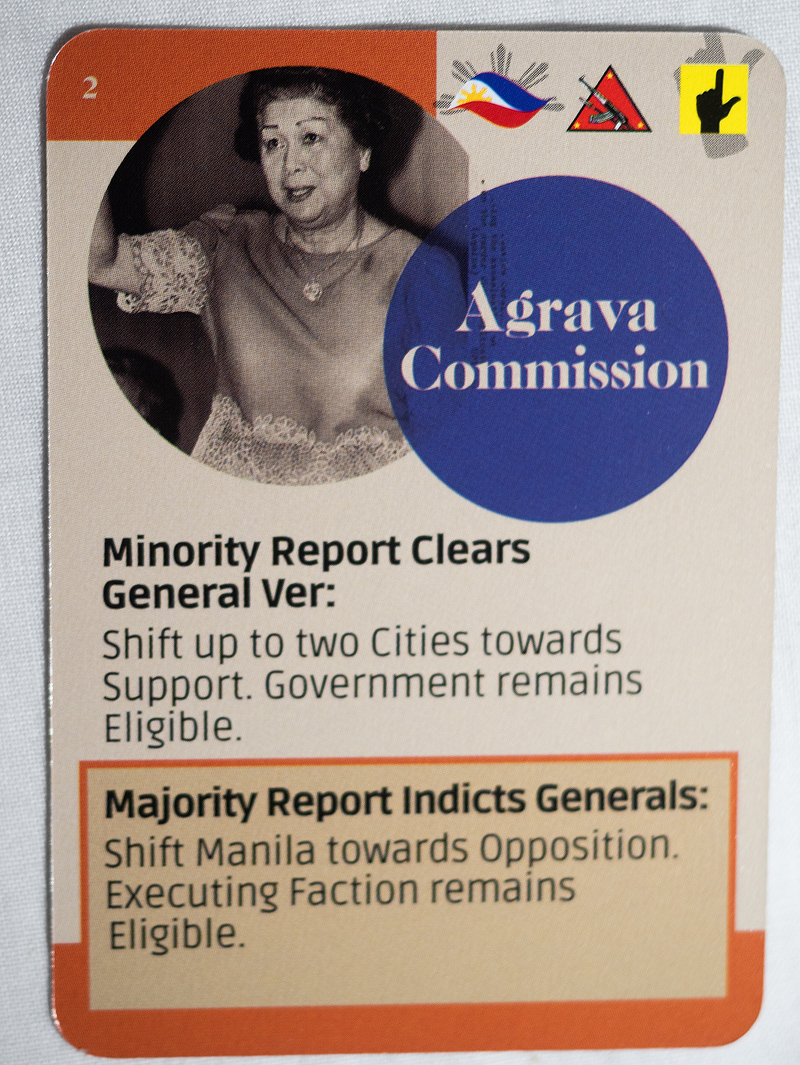
Event card duality
In fact, I’d say that every aspect of this game evokes what they were meant to represent in real life which is interesting since the game is not a simulation, it is quite abstract. But the design is so tight and well made that every Operation, Special Activity, Personality Card makes you feel what it meant to conduct a rebel ambush, radicalize protesters or charm foreign dignitaries. Too many times we see games with mechanics for mechanics sake. This is game mechanics with intent. And everything meshes together to not only play a solid strategic level game but provides a very compelling historical discourse.
Good geopolitical wargames present historical events in an apolotical manner. The design favors factuality and makes no moral judgments. Thus, in a World War 2 wargame, playing a German side does not promote Nazi values nor does it make that player a Nazi supporter. But it does show the player the German predicament during the war and can lend to further analysis of the situation; i.e. was crucial information overlooked, were resources spent unwisely, was momentum wasted, etc. – and the same can be said of People Power. Mr. Tee ( the designer) succeeds in presenting this game as apolitically as possible while retaining factual, documented events and providing a good analysis piece of the period. As polarizing as some of these events are, he illustrates them from the context of each faction’s perspective lending to a politically neutral game. Nevertheless, people who have strong political views on the topic may find some portions of the game biased, but in my opinion, this is more a matter of personal experience or emotion rather than the game favoring specific viewpoints.
Laban! (Fight!)
Historicity in a compelling game design, that’s how I would summarize People Power. Faction asymmetry, a triangular dynamic, variable actions and victory conditions, multi purpose card play, action choice restricting the next player’s options, choosing powerful actions versus choosing to play next turn, these are just some of the systems that make COIN games what they are.
Add to this the setting- my country, my time as a teenager, during the most pivotal event in recent Philippine history, whose ramifications are still felt today – and with abstract gameplay that brings this period to life in such a visceral manner, how can I not recommend this to every Filipino gamer. But this game has more to offer, and not just to Pinoys.
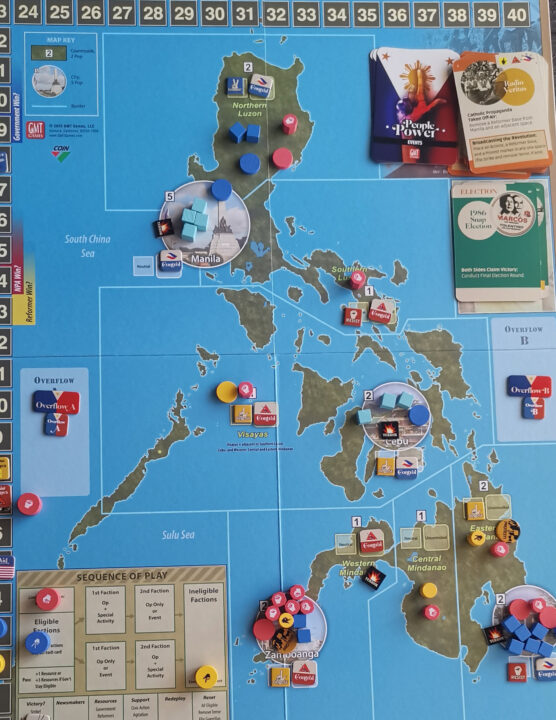
A game in progress. Terror reigns over Manila.
If you are a Filipino and interested in gaming; no matter what political allegiance you have, play this game. No matter what ‘faction’ you think you belong to, you will find a game of novel design and could possibly learn something here. If you are a student or teacher of Philippine history, this could be a new tool at your disposal. If you are a casual gamer and have been wanting to dip into the world of geopolitical games and wargames and wondered what the fuss about GMT games is, try this game. It is accessible enough and doesn’t take that long to play. If you are a wargamer who has shunned COIN because it seemed too complex or too long, play this game. I think this is the best introduction to the series. If you are a eurogamer, try this game, it has some meaty decision making and interesting interactions, and trust me when I say, you haven’t played a game quite like COIN yet.
And to designer Kenneth Tee, my congratulations on a superlative effort. The design notes say it took you 10 years to develop and refine. Your hard work paid off. The game is challenging, smooth to play, and looks amazing on table. It goes without saying this game gets my highest recommendation. Cheers.
Related articles:
Marvel: Age of Heroes Review | The Powers of X


